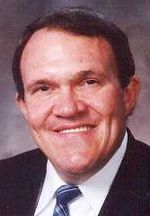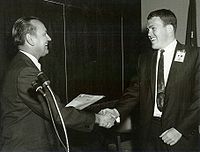
Jack Garman
Encyclopedia

NASA
The National Aeronautics and Space Administration is the agency of the United States government that is responsible for the nation's civilian space program and for aeronautics and aerospace research...
executive and a noted key figure of the Apollo 11
Apollo 11
In early 1969, Bill Anders accepted a job with the National Space Council effective in August 1969 and announced his retirement as an astronaut. At that point Ken Mattingly was moved from the support crew into parallel training with Anders as backup Command Module Pilot in case Apollo 11 was...
lunar landing. As a young specialist on duty during the final descent stage on 20 July 1969 he dealt with a series of computer alarms which could have caused the mission to be aborted.
Early life
Garman was born in Oak Park, IllinoisOak Park, Illinois
Oak Park, Illinois is a suburb bordering the west side of the city of Chicago in Cook County, Illinois, United States. It is the twenty-fifth largest municipality in Illinois. Oak Park has easy access to downtown Chicago due to public transportation such as the Chicago 'L' Blue and Green lines,...
and attended the University of Michigan
University of Michigan
The University of Michigan is a public research university located in Ann Arbor, Michigan in the United States. It is the state's oldest university and the flagship campus of the University of Michigan...
. He graduated in 1966 with a bachelor of science degree in engineering physics and a specialty in computing.
NASA career
In 1966 at the age of twenty-one Garman was hired by NASANASA
The National Aeronautics and Space Administration is the agency of the United States government that is responsible for the nation's civilian space program and for aeronautics and aerospace research...
. He chose to specialize in onboard computing and was assigned to the Apollo Guidance Program Section where he worked with MIT, supervising the design and testing of the Apollo Guidance Computer
Apollo Guidance Computer
The Apollo Guidance Computer provided onboard computation and control for guidance, navigation, and control of the Command Module and Lunar Module spacecraft of the Apollo program...
.
During the Apollo
Project Apollo
The Apollo program was the spaceflight effort carried out by the United States' National Aeronautics and Space Administration , that landed the first humans on Earth's Moon. Conceived during the Presidency of Dwight D. Eisenhower, Apollo began in earnest after President John F...
missions Garman worked in a support role, advising flight controller
Flight controller
Flight controllers are personnel who aid in the operations of a space flight, working in Mission Control Centers such as NASA's Mission Control Center, or ESA's Operations Center. Flight controllers sit at computer consoles and use telemetry to monitor in real time various technical aspects of a...
s in Mission Control on the operation of spacecraft computer systems. A few months before the Apollo 11
Apollo 11
In early 1969, Bill Anders accepted a job with the National Space Council effective in August 1969 and announced his retirement as an astronaut. At that point Ken Mattingly was moved from the support crew into parallel training with Anders as backup Command Module Pilot in case Apollo 11 was...
mission he suggested that simulation supervisors at Mission Control test how flight controllers might react to a computer error code. Guidance officer
Flight controller
Flight controllers are personnel who aid in the operations of a space flight, working in Mission Control Centers such as NASA's Mission Control Center, or ESA's Operations Center. Flight controllers sit at computer consoles and use telemetry to monitor in real time various technical aspects of a...
Steve Bales
Steve Bales
Steve Bales is a former NASA engineer and flight controller. He is best known for his role during the Apollo 11 lunar landing.-Early life:Bales was born in Ottumwa, Iowa, and grew up in the nearby town of Fremont. His father was a school janitor and his mother was a beautician...
responded to the simulated error by calling an abort, which was found to be a needless reaction for that particular code. As Garman later recounted, "Gene Kranz
Gene Kranz
Kranz's book, titled Failure Is Not an Option, published five years after the movie, stated, "...a creed that we all lived by: "Failure is not an option."" . The book has three index references for the phrase, but none of those give any indication of the phrase being apocryphal...
, who was the real hero of that whole episode, said, 'No, no, no. I want you all to write down every single possible computer alarm that can possibly go wrong.'" Garman made a handwritten list of every computer alarm code that could occur along with the correct reaction to each of them and put it under the plexiglass on his desk.
1202

Apollo 11
In early 1969, Bill Anders accepted a job with the National Space Council effective in August 1969 and announced his retirement as an astronaut. At that point Ken Mattingly was moved from the support crew into parallel training with Anders as backup Command Module Pilot in case Apollo 11 was...
. This led to a switch in the lunar landing module
Apollo Lunar Module
The Apollo Lunar Module was the lander portion of the Apollo spacecraft built for the US Apollo program by Grumman to carry a crew of two from lunar orbit to the surface and back...
(LM) being set to the wrong position. As a result, (and unknown to anyone at the time), the onboard guidance computer
Apollo Guidance Computer
The Apollo Guidance Computer provided onboard computation and control for guidance, navigation, and control of the Command Module and Lunar Module spacecraft of the Apollo program...
was needlessly processing data from the rendezvous radar
Radar
Radar is an object-detection system which uses radio waves to determine the range, altitude, direction, or speed of objects. It can be used to detect aircraft, ships, spacecraft, guided missiles, motor vehicles, weather formations, and terrain. The radar dish or antenna transmits pulses of radio...
. Then, as the LM descended, its separate landing radar acquired the lunar surface. Now processing data from two radars instead of only one as intended, the computer's duty cycle grew heavier than expected and a series of "1202" and "1201" alarms began signalling an executive overflow, meaning that the computer did not have enough time to execute all tasks so lower priority tasks were being dropped. Several seconds after the first alarm Neil Armstrong
Neil Armstrong
Neil Alden Armstrong is an American former astronaut, test pilot, aerospace engineer, university professor, United States Naval Aviator, and the first person to set foot upon the Moon....
, with some concern apparent in his voice said, "Give us a reading on the 1202 program alarm." Meanwhile, given his knowledge of the computer systems, Garman had already advised Steve Bales the computer could be relied upon to function adequately so long as the alarms did not become continuous. Bales, who as guidance officer had to quickly decide whether to abort the mission over these alarms, trusted Garman's judgement and informed flight director Kranz. Within seconds this decision was relayed through CAPCOM to the astronauts, Apollo 11 landed successfully and Garman received an award from NASA for his role in the mission.
Bales later recalled, "Quite frankly, Jack, who had these things memorized said, 'that's okay', before I could even remember which group it was in".
IT and senior management
After the Apollo program, Garman and center director Dr Chris Kraft collaborated in the then-new Spacecraft Software Division where Garman worked on Space ShuttleSpace Shuttle
The Space Shuttle was a manned orbital rocket and spacecraft system operated by NASA on 135 missions from 1981 to 2011. The system combined rocket launch, orbital spacecraft, and re-entry spaceplane with modular add-ons...
software, including the Flight Computer Operating System (FCOS) and the high-level programming language HAL/S
HAL/S
HAL/S is a real-time aerospace programming language, best known for its use in the Space Shuttle program. It was designed by Intermetrics in the 1970s for NASA. HAL/S is written in XPL, a dialect of PL/I....
. From 1986 through 1988 he worked at NASA Headquarters in Washington, D.C.
Washington, D.C.
Washington, D.C., formally the District of Columbia and commonly referred to as Washington, "the District", or simply D.C., is the capital of the United States. On July 16, 1790, the United States Congress approved the creation of a permanent national capital as permitted by the U.S. Constitution....
as director of information systems services in the Space Station Program Office. Returning to Johnson Space Center in 1988 he held various senior positions in information systems, finally serving as Chief Information Officer of Johnson Space Center from 1994 through 2000.
Lockheed Martin
In 2000, Garman left NASA and became a part of the OAO Corporation. Two years later OAO was bought by Lockheed MartinLockheed Martin
Lockheed Martin is an American global aerospace, defense, security, and advanced technology company with worldwide interests. It was formed by the merger of Lockheed Corporation with Martin Marietta in March 1995. It is headquartered in Bethesda, Maryland, in the Washington Metropolitan Area....
and Garman became Lockheed Martin's technical director of NASA services, in charge of technical support for the company's contractual activities with NASA.

